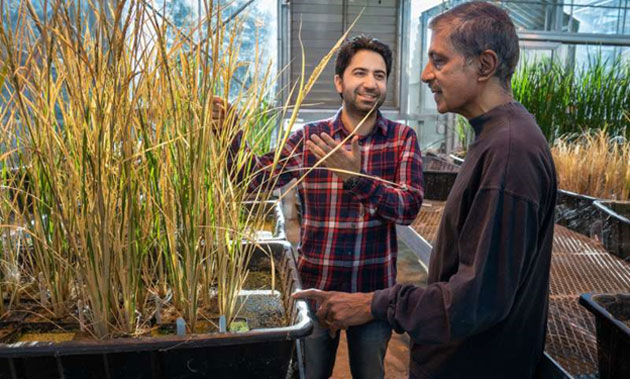The USDA has defined food insecurity as the lack of consistent access to food to sustain a healthy living. An estimated 1 in 8 Americans, including about 12 million children, were found to be ‘food insecure,’ in 2017, according to a recent paper published by the U.S. Department of Agriculture (USDA).
In addition, overall, there has been an increase in world hunger, with nearly 821 million people in 2017 (804 million in 2016) suffering from chronic food deprivation and undernourishment, despite recent innovations in urban farming like vertical cities, food computers, and speed breeding. This deterioration in number has been associated with climate change and instability and conflicts in many regions of the world.
To address this issue, i.e., in making crops disease-resistant, high-yielding and climate-tolerant, a team of plant biologists at the University of California, Davis, Iowa State University and INRA, France, led by Prof. Venkatesan Sundaresan, has found a way to make rice plants replicate through their hybrid cloned seeds.
Why rice? These grain-crops provide for more than 50% of the majority of the world’s population.
For more than 10,000 years, rice has been reproducing sexually by rearranging its DNA through the generations. This is the first-time asexual reproduction in the wild — known as apomixis — in rice plants has been attempted.
Since the twentieth century, hybrid seeds were created by crossing two varieties, but the offspring often fell short as they were unable to retain the characteristics of the parents. The new variety, as per the study, produced an exact replica, a clone, of the rice plant from its seeds.
This work has been published in a recent issue of the Nature journal.
Developing the Clonal Hybrid Rice Seeds
The experiment involved the researchers altering two sets of genes in the japonica rice (Oryza sativa) hybrid, Kitaake, in order to clone its seeds.
They did this because it was previously found that the rice gene, BABY BOOM1 (BBM1), was active in the sperm cells, which further led to the development of the embryo and then the whole seed. Following this, the idea arose to activate the BBM1 gene in only the egg cells. This would essentially induce a process called parthenogenesis, i.e., the reproduction from an ovum (and no sperm) without fertilization.
Australia’s Commonwealth Scientific and Industrial Research Organization, Anna Koltunow, who was not involved in the research said, “The study clearly shows one can re-engineer rice to switch it from a sexual to an asexual mode.”
On the other hand, it has been proven that the natural phenomenon of meiosis acts as a “roadblock” and prevents asexual reproduction. Scientists of this study deactivated this form of cell division in the rice plants with the help of CRISPR-Cas9 genome editing (changing certain DNA sequences). They did this using a strategy introduced by Raphael Mercier of INRA, France, also a co-author of the paper.
After this was performed and the BBM1 introduced into the sequence, the investigators observed that the egg cells developed into embryos, which strongly resembled the parent plant, and in turn, they formed into clonal seeds. When planted, these seeds grew into a complete rice plant, which continued for three generations.

Prof. Venkatesan Sundaresan (right) and a colleague, Imtiyaz Khanday (left), with their cloned rice plants in the university greenhouse. (Source: UC Regents)
The results intrigued Sundaresan and the team; he said, “We were actually surprised as well as excited that it worked as well as it did in our very first experiments. Now that the road has been opened, it would be fantastic to have it working at maximum efficiency out in the field, so farmers who can’t afford hybrid seeds could still obtain the full benefits of hybrids from their home-grown seeds.”
Now that asexual reproduction has been attempted, and the genes in rice have been tweaked to produce results, the biologists suggested a similar approach could be applied to other important food crops such as corn, wheat, and tomatoes.
Research like this can take global agriculture to the next level by solving the problems of the poor farmers and the issue of food insecurity, simultaneously.
Top Image: Scientists have, for the first time, made rice plants reproduce asexually. (Source: Pixabay)
References
- Understand Food Security, Hunger + Health: Feeding America, https://hungerandhealth.feedingamerica.org/understand-food-insecurity/, (accessed Dec 27, 2018)
- Jensen, A. et al. (2018), ‘Household Food Security in the United States in 2017, ERR-256’, U.S. Department of Agriculture, Economic Research Service
- Food Security & Nutrition around the World, Food and Agriculture Organization of the United Nations (FAO), http://www.fao.org/state-of-food-security-nutrition/en/, (accessed Dec 27, 2018)
- Hybrid rice engineered with CRISPR can clone its seeds, 2018, ScienceNews, https://www.sciencenews.org/article/hybrid-rice-engineered-crispr-can-clone-its-seeds, (accessed Dec 28, 2018)
- Rice plants that grow as clones from seed, 2018, Phys.org, https://phys.org/news/2018-12-rice-clones-seed.html, (accessed Dec 28, 2018)
- First Clonal Rice Seeds Are an Agricultural Dream Come True, 2018, Innovative Genomics Institute, https://innovativegenomics.org/news/first-clonal-rice-seeds/, (accessed Dec 30, 2018)







No comment